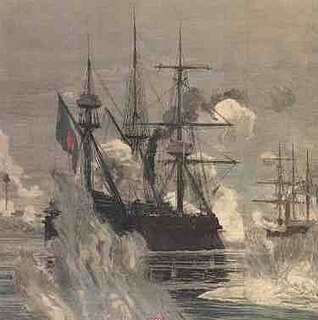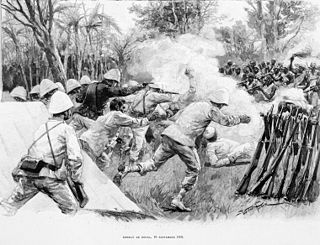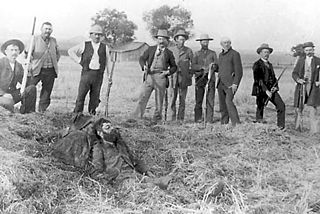 W
WThe Second Battle of Agordat was fought in late December 1893, between Italian colonial troops and Mahdists from the Sudan. Emir Ahmed Ali campaigned against the Italian forces in eastern Sudan and led about 10–12,000 men east from Kassala. This force encountered 2,400 Italians and their Eritrean askaris at Agordat, west of Asmara, commanded by Colonel Arimondi. Over 1,000 Dervishes, including the Emir, were killed in severe fighting. The outcome of the battle constituted:"...the first decisive victory yet won by Europeans against the Sudanese revolutionaries,..."
 W
WThe Argentine Revolution of 1893, or the Radical Revolution of 1893, was a failed insurrection by members of the Radical Civic Union (UCR) against the government of Argentina, then controlled by the National Autonomist Party (PAN). It continued the goals of the Revolution of the Park of 1890, whose themes were further echoed in the Revolution of 1905.
 W
W W
WThe Black Week was a crisis in Honolulu, Hawaii that nearly caused a war between the Provisional Government there and United States.
 W
WThe Congo–Arab War took place in what is now the Democratic Republic of the Congo between the forces of Belgian King Leopold II's Congo Free State and various Zanzibari Arab slave traders led by Sefu bin Hamid, the son of Tippu Tip. Fighting occurred in the eastern Congo between 1892 and 1894. It was a proxy war, with most of the fighting being done by native Congolese, who aligned themselves with either side and sometimes switched sides. The causes of the war were largely economic based, since Leopold and the Arabs were contending to gain control of the wealth of the Congo. The war ended in January 1894 with a victory of Leopold's Force Publique. Initially, King Leopold II collaborated with the Arabs, but competition struck over the control of ivory and the topic of Leopold II's humanitarian pledges to the Berlin Conference to end slavery. Leopold II's stance turned confrontational against his once-allies. The war against the Swahili-Arab economic and political power was presented as a Christian anti-slavery crusade.
 W
WThe Enid–Pond Creek Railroad War occurred in Oklahoma Territory between 1893 and 1894, and pitted the citizens of two United States designated county seats against the Rock Island Railroad.
 W
WThe Federalist Riograndense Revolution (1893–1895) was a civil war which occurred in southern Brazil against the recently-formed Republic. Urged by the political crisis generated by the federalists, an opposition group that sought to liberate Rio Grande do Sul from the governance of Julio de Castilhos, then president of the state, and also gain greater autonomy and decentralize the power of the then newly proclaimed Republic.
 W
WThe First Matabele War was fought between 1893 and 1894 in modern day Zimbabwe. It pitted the British South Africa Company against the Ndebele (Matabele) Kingdom. Lobengula, king of the Ndebele, had tried to avoid outright war with the company's pioneers because he and his advisors were mindful of the destructive power of European-produced weapons on traditional Matabele impis attacking in massed ranks. Lobengula reportedly could muster 80,000 spearmen and 20,000 riflemen, armed with Martini-Henry rifles, which were modern arms at that time. However, poor training meant that these were not used effectively.
 W
WThe First Melillan campaign, also called the Melilla War or the Margallo War in Spain, was a conflict between Spain and 39 of the Rif tribes of northern Morocco, and later the Sultan of Morocco, that began in October 1893, was openly declared November 9, 1893, and was resolved by the Treaty of Fez in 1894.
 W
WThe Franco-Siamese War of 1893 was a conflict between the French Third Republic and the Kingdom of Siam. Auguste Pavie, French vice consul in Luang Prabang in 1886, was the chief agent in furthering French interests in Laos. His intrigues, which took advantage of Siamese weakness in the region and periodic invasions by Vietnamese rebels from Tonkin, increased tensions between Bangkok and Paris. Following the conflict, the Siamese agreed to cede Laos to France, an act that led to the significant expansion of French Indochina.
 W
WThe Garza Revolution, or the Garza War, was an armed conflict fought in the Mexican state of Coahuila and the American state of Texas between 1891 and 1893. It began when the revolutionary Catarino Garza launched a campaign into Mexico from Texas to start an uprising against the dictator Porfirio Diaz. Because of this violation of neutrality, the United States Army became involved and assisted the Mexican Army in tracking down Garza's followers. The war was relatively minor compared to other similar conflicts in Mexican history though it has been seen as a precursor to the major Mexican Revolution from 1910 to 1920.
 W
WThe overthrow of the Hawaiian Kingdom began on January 17, 1893, with a coup d'état against Queen Liliʻuokalani on the island of Oahu by subjects of the Hawaiian Kingdom, United States citizens, and foreign residents residing in Honolulu. A majority of the insurgents were foreigners. They prevailed upon American minister John L. Stevens to call in the U.S. Marines to protect United States interests, an action that effectively buttressed the rebellion. The revolutionaries established the Republic of Hawaii, but their ultimate goal was the annexation of the islands to the United States, which occurred in 1898.
 W
WThe Leper War on Kauaʻi also known as the Koolau Rebellion, Battle of Kalalau or the short name, the Leper War. Following the overthrow of the Kingdom of Hawaii, the stricter government enforced the 1865 "Act to Prevent the Spread of Leprosy" carried out by Attorney General and President of the Board of Health William Owen Smith. A revolt broke out in Kauaʻi, against the forced relocation of all infected by the disease to the Kalaupapa Leprosy Colony of Kalawao on the island of Molokai.
 W
WThe Paknam Incident was a military engagement fought during the Franco-Siamese War in July 1893. While sailing off Paknam on Siam's Chao Phraya River, three French ships violated Siamese territory and were fired warning shots by a Siamese fort and a force of gunboats. In the ensuing battle, France won and blockaded Bangkok, which ended the war.
 W
WThe Second Franco-Dahomean War, which raged from 1892 to 1894, was a major conflict between the French Third Republic, led by General Alfred-Amédée Dodds, and the Kingdom of Dahomey under King Béhanzin. The French emerged triumphant and incorporated Dahomey into their growing colonial territory of French West Africa.
 W
WThe Shangani Patrol was a 34-soldier unit of the British South Africa Company that in 1893 was ambushed and annihilated by more than 3,000 Matabele warriors in pre-Southern Rhodesia, during the First Matabele War. Headed by Major Allan Wilson, the patrol was attacked just north of the Shangani River in Matabeleland, Rhodesia. Its dramatic last stand, sometimes called "Wilson's Last Stand", achieved a prominent place in the British public imagination and, subsequently, in Rhodesian history, similarly to events such as the Battle of the Little Bighorn in the United States, the Battle of Shiroyama in Japan, the Battle of the Alamo in Texas, and the Greeks' last stand at Thermopylae.
 W
WThe Battle of the Shangani took place on 25 October 1893, during the First Matabele War in what is now Zimbabwe. A British column was attacked during night by a large force of Matabele warriors. The British were able to repulse them with heavy loss of life to the Matabele force. The battle is noted for being the first battle in which the Maxim gun played an important role.
 W
WThe Battle of Stone Corral, also known as the Gunfight at Stone Corral, occurred in June 1893 and was the final shootout during the pursuit of the Sontag-Evans Gang. After months of searching and several previous encounters, a small posse under the command of Marshal George E. Gard ambushed John Sontag and Chris Evans at a corral near Visalia, California.
 W
WThe Battle of Tres Jacales was an Old West gunfight that occurred on June 30, 1893. While out searching for a gang of rustlers, a group of American lawmen under the command of the Texas Ranger Frank Jones were attacked at the Mexican village of Tres Jacales. During the exchange of gunfire, Jones was mortally wounded and the remaining Americans were forced to retreat back into Texas.
 W
WThe Tucker County Seat War was a dispute between the towns of Parsons and St. George, in Tucker County, West Virginia, over which should be the county seat.